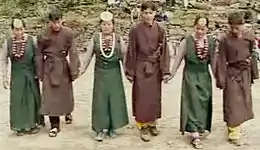Dhan Nach
Dhan Nach (Nepali: धाननाच) or Yalang (Limbu: ᤕᤠᤗᤠᤅ; [jaˀlaːŋ]) is a traditional Limbu folk dance, which originated in the Limbuwan region of Nepal.[1] It is performed by people from Limbu (Yakthung) communities, native to Eastern Nepal as well as Darjeeling, Kalimpong and Sikkim regions of India. The dance is accompanied by a folk song known as Palam.[2]
 | |
| Native name | धाननाच ᤕᤠᤗᤠᤅ |
|---|---|
| Etymology | Paddy dance |
| Genre | Folk dance |
| Origin | Limbuwan region |
Etymology
Dhan Nach in Nepali translates to paddy dance (Dhan translates to paddy, nach translates to dance). The dance is also commonly known as Yalang. It is known by multiple names in Limbu communities according to their languages. In Chhathare Limbu language, it is known as Chalakma. In Panthare Limbu language, it is known as Yalakma. In every language, the name of the dance translates to paddy dance.[3]
Origin mythology
According to local legend, there was a drought in a village and people were dying of starvation. Then Makcharepu (Limbu: ᤔᤠᤰᤆᤖᤣᤐᤢ; transl. paddy bird), a bird brought some seeds of Khaiya type of paddy and gave it to the villager to cultivate it. The villager did so and received a fruitful harvest. But the birds started eating most of the harvest.[4] The villagers tried to shoo the bird away but the birds demanded the harvest since they were the ones who brought the seed. The villagers were unable to refute to that claim and agreed. The birds would directly eat the rice as soon as it was thrashed. So, the people started to loudly shout " Ha... Ha... Ha..." to scare away the birds, which later became the rhythmic Palam song. While singing Palam, the people would hold hand dance over the paddy harvest which would separate the husk away from the rice. After which, the people started performing Dhan Nach every year during the month of Mangsir.[5]
Tradition
The dance is performed during multiple occasions such as marriage, festivals such as Udhauli, carnivals and celebrations. It can be performed in pairs or in groups. It is performed by men and women without any blood relations holding hands and dancing either in a straight line or a circulus.[3] Historically, the dance was performed for seven days and seven nights.
In recent days, the dance is on the verge of extinction with young people's lack of participation.[6][7] However, various cultural organizations are raising awareness for preservation and promotion of this dance form.[8]
In popular media
In 2021, a short film titled Kheda was released to raise awareness about the dance form.[9]
References
- Rai, Rohit. "DHAN NACH IN DHARAN". My City. Archived from the original on 2022-07-09. Retrieved 2022-02-23.
- "धाननाच जोगाउने चिन्ता". धाननाच जोगाउने चिन्ता. Archived from the original on 2022-02-23. Retrieved 2022-02-23.
- "'गीत गाउन... अनुरोध गरेँ है !'". GorakhaPatra. Archived from the original on 2022-02-23. Retrieved 2022-02-23.
- श्रेष्ठ, शिवकुमार (2021-03-20). "किराती लोककथा/ दन्त्यकथा-धाननाचको उत्पत्ति". Shabda Sopan. Archived from the original on 2022-02-23. Retrieved 2022-02-23.
- Limbu, Suman (2020-09-05). "धाननाच". Jharana Sanchar (in Nepali). Archived from the original on 2022-02-23. Retrieved 2022-02-23.
- "लिम्बू समुदायको धाननाच लोप हुँदै, संरक्षणमा युवापुस्ताको ध्यान गएन". Nagarik Khabar. 2021-10-17. Archived from the original on 2022-02-23. Retrieved 2022-02-23.
- "धान नाच लोप हुने खतरा बढ्दै". Imagekhabar - Online News Portal of Nepal. Archived from the original on 2022-02-23. Retrieved 2022-02-23.
- "लोप हुँदै गएको धान नाँच संरक्षण गर्न कार्यक्रम". Purbeli News. 2019-07-29. Archived from the original on 2022-02-23. Retrieved 2022-02-23.
- "लिम्बू जातिको धाननाच प्रस्तुत गरिएको लघुचलचित्र 'खेदा' सार्वजनिक (भिडियो)". युग खबर. 2021-07-08. Archived from the original on 2022-02-23. Retrieved 2022-02-23.